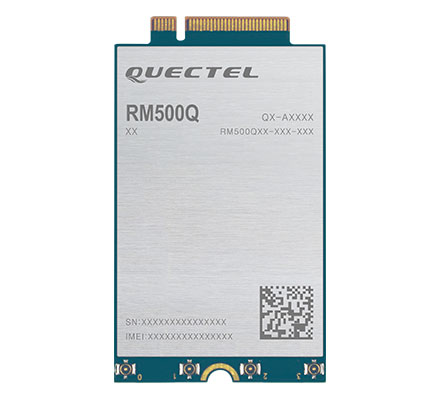| Frequency Bands |
5G NR : n1/n2/n3/n5/n7/n8/n12/n20/n25/n28/n38/n40/n41/n48/n66/n71/n77/n78/n79
LTE-FDD : B1/B2/B3/B4/B5/B7/B8/B9/B12/B13/B14/B17/B18/B19/B20/B25/B26/B28/B29/B30/B32/B66/B71
LTE-TDD : B34/B38/39/B40/B41/B42/B43/B48
LTE LAA : B46 (only support 2x2 MIMO)
WCDMA : B1/B2/B3/B4/B5/B6/B8/B19
GNSS : GPS/GLONASS/BeiDou (Compass)/Galileo |
| Power Supply |
Supply voltage range: 3.3–4.4 V
Typical supply voltage: 3.7 V |
| Transmitting Power |
Class 3 (24 dBm +1/-3 dB) for WCDMA bands
Class 3 (23 dBm ±2 dB) for LTE bands
Class 3 (23 dBm ±2 dB) for 5G NR bands
Class 2 (26 dBm ±2 dB) for LTE B38/B40/B41/B42 bands HPUE
Class 2 (26 dBm +2/-3 dB) for 5G NR n41/n77/n78/n79 bands HPUE |
| Data Transmission |
5G SA Sub-6 Data Rate (Mbps) : DL 2.1 Gbps; UL 900 Mbps
5G NSA Sub-6 Data Rate (Mbps) : DL 2.5 Gbps; UL 650 Mbps
LTE Data Rate (Mbps) : DL 1.0 Gbps; UL 200 Mbps
WCDMA Data Rate (Mbps) : DL 42 Mbps; UL 5.76 Mbps |
| 5G NR Features |
Supports 3GPP Rel-15
Supported modulations:
Uplink: π/2-BPSK, QPSK, 16QAM, 64QAM and 256QAM
Downlink: QPSK, 16-QAM, 64-QAM and 256-QAM
Supported MIMO:
Uplink: 2 × 2 MIMO* on n41/n77/n78/n79
Downlink: 4 × 4 MIMO on n1/n2/n3/n7/n25/n38/n40/n41/n48/n66/n77/
n78/n79
Supports SCS 15 kHz and 30 kHz
Supports SA and NSA operation modes
Supports Option 3x, 3a and Option 2
RG500Q-EA:
NSA: Max. 2.5 Gbps (DL)/650 Mbps (UL)
SA: Max. 2.1 Gbps (DL)/900 Mbps (UL)
RG500Q-NA*:
NSA: Max. 2.5 Gbps (DL)/650 Mbps (UL)
SA: Max. 2.1 Gbps (DL)/450 Mbps (UL)
RG502Q-EA:
NSA: Max. 5.0 Gbps (DL)/650 Mbps (UL)
SA: Max. 4.2 Gbps (DL)/900 Mbps (UL) |
| LTE Features |
Supports 3GPP Rel-15
Supports up to CA Cat 16 FDD and TDD
Supported modulations:
Uplink: QPSK, 16-QAM, 64-QAM and 256-QAM
Downlink: QPSK, 16-QAM, 64-QAM and 256-QAM
Supports 1.4/3/5/10/15/20 MHz RF bandwidth
Supports DL 4 × 4 MIMO on B1/B2/B3/B4/B7/B25/B30/B32/B34/B38/B39/
B40/B41/B42/B43/B46/B48/B66
RG500Q-EA:
LTE: Max. 1.0 Gbps (DL)/200 Mbps (UL)
RG500Q-NA*:
LTE: Max. 1.0 Gbps (DL)/200 Mbps (UL)
RG502Q-EA:
LTE: Max. 2.0 Gbps (DL)/200 Mbps (UL) |
| UMTS Features |
Supports 3GPP Rel-9 DC-HSDPA, HSPA+, HSDPA, HSUPA and WCDMA
Supports QPSK, 16-QAM and 64-QAM modulations
DC-HSDPA: Max. 42 Mbps
HSUPA: Max. 5.76 Mbps
WCDMA: Max. 384 kbps (DL)/384 kbps (UL) |
| Internet Protocol Features |
Supports QMI/TCP*/UDP*/FTP*/HTTP*/NTP*/PING*/HTTPS*/SMTP*/
MMS*/FTPS*/SMTPS*/SSL* protocols |
| SMS |
Text and PDU modes
Point-to-point MO and MT
SMS cell broadcast
SMS storage: ME by default |
| (U)SIM Interfaces |
Supports SIM/USIM cards: 1.8/2.95 V |
| Audio Features |
Supports two digital audio interfaces: PCM* and I2S 2)
WCDMA: AMR/AMR-WB
LTE: AMR/AMR-WB
Supports echo cancellation and noise suppression |
| PCM Interface |
Supports 16-bit linear data format
Supports long frame synchronization and short frame synchronization
Supports master and slave modes, but must be in master mode for long
frame synchronization |
| I2S Interface |
Supports 16-bit linear data format
I2S is commonly used as a 4-wire DAI (normally I2S_MCLK is not used in
the design) in Hi-Fi, STB and portable devices. The Tx and Rx lines are
used for audio transmission, while the bit clock and left/right clock
synchronize the link. I2S is flexible in that either the controller or codec can
drive (master) the bit clock and left/right clock lines.
Can be multiplexed to PCM function |
| USB Interface |
Compliant with USB 3.1 and 2.0 specifications, with maximum transmission
rates of up to 10 Gbps on USB 3.1 and 480 Mbps on USB 2.0
Used for AT command communication, data transmission, GNSS NMEA
output, software debugging and firmware upgrade
Supports USB serial drivers for: Windows 7/8/8.1/10, Linux 2.6–5.4,
Android 4.x–9.x
USB Serial Driver : Windows 7/8/8.1/10, Linux 2.6–5.4, Android 4.x/5.x/6.x/7.x/8.x/9.x/10
GNSS Driver : Android 4.x/5.x/6.x/7.x/8.x/9.x/10
RIL Driver : Android 4.x/5.x/6.x/7.x/8.x/9.x/10
NDIS Driver : Windows 7/8/8.1/10
MBIM Driver : Windows 7/8/8.1/10, Linux 3.18–5.4
GobiNet Driver : Linux 2.6–5.4
QMI_WWAN Driver : Linux 3.4–5.4 |
| UART Interfaces |
Main UART:
Used for AT command communication
Baud rate: 115200 bps by default
Supports RTS and CTS hardware flow control
Debug UART:
Used for Linux console and log output
Baud rate: 115200 bps
BT UART:
Used for BT communication
Baud rate: 115200 bps
COEX UART:
Used for WWAN/WLAN coexistence algorithms |
| PCIe Interface |
Compliant with PCI Express Specification Revision 3.0
Supports 2 lanes, 8 Gbps/lane
Can be used to connect an external WLAN IC |
| Rx-diversity |
Supports 5G NR/LTE/WCDMA Rx-diversity |
| GNSS Features |
Gen9C Lite of Qualcomm
Supports dual-band GNSS: L1 and L5
Protocol: NMEA 0183
Data update rate: 1 Hz |
Antenna Tuner Control
Interface |
GRFC interface dedicated for external antenna tuner |
| AT Commands |
Compliant with 3GPP TS 27.007, 27.005 and Quectel enhanced AT
commands |
| Network Indication |
Two pins NET_MODE* and NET_STATUS to indicate network connectivity
status |
| Antenna Interfaces |
Eight cellular antenna interfaces (ANT0–ANT7) and one GNSS antenna
interface (ANT_GNSS) |
| Physical Characteristics |
52.0mm x 30.0mm x 2.3mm, 8.4g |
| Operating Temperature |
Standard operating temperature range : -20 to 60°C
Operating temperature range: -30 °C to +75 °C
To meet this operating temperature range, you need to ensure effective thermal dissipation, for
example, by adding passive or active heatsinks, heat pipes, vapor chambers, etc. Within this range,
the module can meet 3GPP specifications.
Extended temperature range: -40 °C to +85 °C
To meet this extended temperature range, you need to ensure effective thermal dissipation, for
example, by adding passive or active heatsinks, heat pipes, vapor chambers, etc. Within this range,
the module remains the ability to establish and maintain functions such as voice, SMS, emergency
call, etc., without any unrecoverable malfunction. Radio spectrum and radio network are not
influenced, while one or more specifications, such as Pout, may undergo a reduction in value,
exceeding the specified tolerances of 3GPP. When the temperature returns to the normal operating
temperature level, the module will meet 3GPP specifications again.
Storage temperature range: -40 °C to +90 °C |
| Firmware Upgrade |
USB 2.0 and DFOTA |

![]()





 CarTFT.com
CarTFT.com



